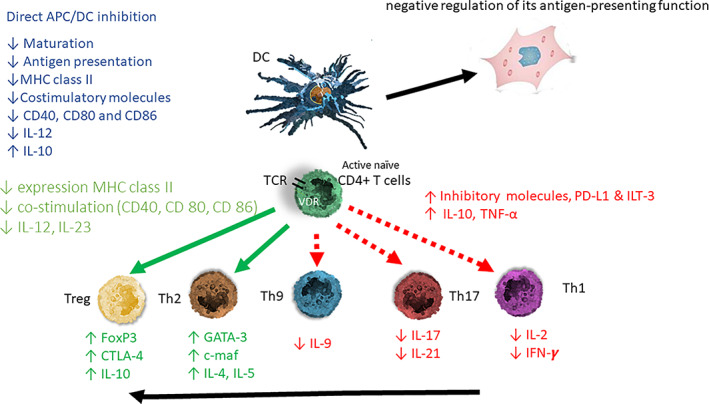Fig. 1.

Schematic presentation of the immune modulating activity of the vitamin D endocrine system. 1,25(OH)2D modulates dendritic cells (DC) toward a less mature and more tolerogenic phenotype with changes in both morphology (more adherent spindle cells), cytokine production, and surface markers with a negative regulation of their antigen‐presenting function. 1,25(OH)2D exerts its effect through direct binding to the vitamin D receptor (VDR) of the antigen‐presenting cell (APC) and to activated T lymphocytes. T‐cell receptor (TCR) signaling induces upregulation in the vitamin D receptor (VDR). 1,25(OH)2D exerts on DC a direct inhibition of APC and a negative regulation of its antigen presentation function. The DC‐derived cytokines will alter the T‐helper (Th) lymphocyte balance from a Th1 and Th17 predominance toward a Th2 phenotype. The direct effect of 1,25(OH)2D on the T lymphocytes creates a change toward a more tolerogenic state with an induction of Thelper‐2 (Th2) lymphocytes and regulatory T lymphocytes (Tregs); depicted in green arrow, together with a downregulation of the pro‐inflammatory Thelper‐1 (Th1) lymphocytes, Thelper‐17 (Th17) lymphocytes, and Thelper‐9 (Th9) lymphocytes (depicted in red arrow). APC = antigen‐presenting cell; DC = dendritic cell; naïve T cells MHC = membrane histocompatibility complex; cluster of differentiation (CD) 80 = CD86 (co‐stimulatory molecules), and CD54 (adhesion molecule); PD‐L1 = programmed death‐ligand 1; ILT‐3 = immunoglobulin‐like transcript, T lymphocytes; TH1 = T helper 1; TH2 = T helper 2; TH17 = T helper 17; Treg = regulatory T cell; IL = interleukin; TNF‐α = tumor necrosis factor‐α; FoxP3 = forkhead box P3 (master gene controlling the development and function of regulatory cells); CTLA‐4 = cytotoxic T lymphocyte‐associated Ag‐4).
